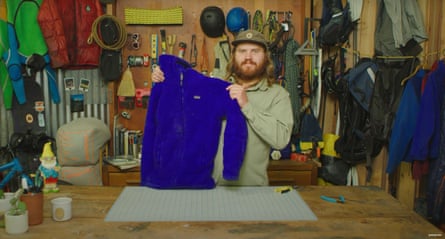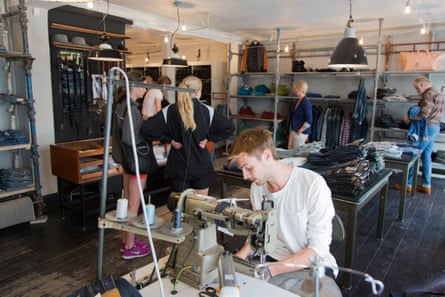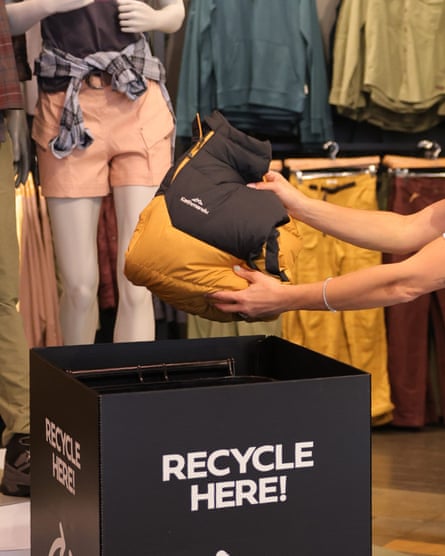
Earlier this month the Australian Fashion Council, in partnership with several organisations and government agencies, announced the final stage of its scheme to reduce the 200,000 tonnes of clothing waste sent to landfill every year in Australia.
The Seamless scheme imposes a four-cent levy on each garment produced by fashion businesses, which will fund research into sustainability for the industry and establish the infrastructure for textile recycling. While the scheme is voluntary – the federal environment minister, Tanya Plibersek, has flagged the industry may face regulation in 12 months’ time – it encourages fashion businesses to embrace circularity and take responsibility for the full life cycle of a garment by making rental, resale and repair available for consumers.
This week, we take a look at four global fashion brands that have successfully integrated repair into their business models – and how they have navigated some trickier aspects like monetisation and garment collection.
Patagonia
Patagonia’s Worn Wear program has been part of the outdoor brand’s DNA since the 1970s. Worn Wear is an umbrella term for a variety of circular initiatives that include personal repair and care tools (including DIY kits and online tutorials), resale and repair services and an upcycled line of vests and bags.
Through the repair-and-resale program, customers can send back eligible items via post or in-store drop-off and receive a voucher for up to 50% of the resale price of the item. The repaired second-hand garments are then sold at a reduced price.
Currently, this scheme is only available in the United States. But when it comes to repairing Patagonia items, the company has 72 repair centres all over the world where items are mended free of charge or for a nominal fee. Corey Simpson, a communications manager for Patagonia, says, “last year we repaired 100,000 items, and we plan to grow that commitment over time”.
The largest stand-alone repair centre is in Reno, Nevada, where Simpson says more than 115 full-time employees repair returned Patagonia items.
Nudie Jeans
Inside every Nudie Jeans store is a repair shop for worn and damaged denim from the Swedish label. The in-store repair program began on a “very small scale around 15 years ago” says Kevin Gelsi, Nudie Jeans’ circular product manager. Back then, each store had a hemming machine to shorten jean-leg lengths but over time, staff used the machines to repair their own jeans and began offering the service to customers.
This became a “word-of-mouth attraction”, says Gelsi, and as the repairs grew in popularity the label decided to make it “an official concept of its own”.

Before long, Nudie Jeans stores also had darning machines to patch up denim; and in 2012 the brand introduced its Reuse take-back program, where customers were offered a 20% discount on a new pair of Nudies in exchange for their old, worn-out pair. The reclaimed jeans were resold, used for patches in repairs, or saved for recycling projects.
Today, the Reuse program has grown to include all Nudie garments, and the discount incentive can be used to purchase second-hand jeans. The numbers point to the program’s success – in 2022, Nudie repaired 65,386 pairs of jeans, resold 3,984 pairs and collected 20,722 post-consumer jeans.
after newsletter promotion
Kathmandu
This year, New Zealand outdoor clothing brand Kathmandu launched Kathman-REDU, a program that takes faulty, returned or unsellable items and cleans, repairs and refurbishes them to sellable condition. The program launched in the Richmond and Galleria Kathmandu stores in Melbourne, with the intention to scale up over time.

Aleasha McCallion from the Monash Sustainable Development Institute worked with Kathmandu to figure out exactly where along the supply chain there were “pockets of waste” that could instead be redirected to more profitable items. “None of their waste is directly going to landfill, but it’s ending up in seconds and not actually being repaired. So, it might be sold at a discount because something’s broken,” she says. “This was really about taking a look at and maximising all of that potential.”
In addition, the brand has a drop-off used clothing scheme in partnership with recycler Upparel. Clothing collection bins have been placed in 24 Kathmandu stores across Melbourne, and customers can donate their old, used or faulty Kathmandu gear. A portion of appropriate items from this initiative will be repaired and returned to retail as a part of the Kathman-REDU scheme.
Asket
In May, Swedish brand Asket opened a bricks-and-mortar retail store in Stockholm dedicated to the sale of reconditioned second-hand garments.
Before committing to a permanent location, cofounders August Bard Bringéus and Jakob Sazon Dworsky ran a twelve-month takeback and repair program – including opening two pop-up retail spaces – to trial the concept. The response was so good they believed a permanent store could be financially viable. So far at the Stockholm store, they have collected some 2,000 worn garments and reconditioned 70% of them.
Customers send pre-loved Asket garments through the mail; in exchange, they receive a voucher of up to 25 euros, depending on the garment. The garments are then sent to Fabrikörerna, a partner factory on the west coast of Sweden, to be repaired for resale.
Currently Asket are searching for a solution for garments that are beyond restoration. “We are in discussion with local remake organisations and continue to look for viable recycling options with a focus on garments being used to create new yarn,” say Bard Bringéus and Dworsky in a joint email response. “The intended solution would include using fabric scraps to remake into unique items or recycling the fabric.”


